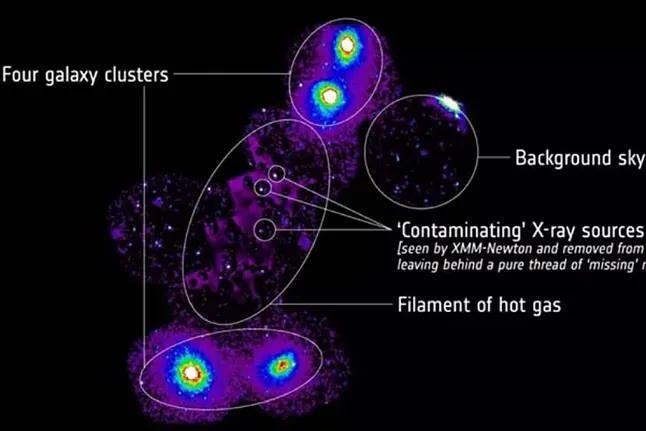Astronomers have discovered a massive hot gas filament that connects four galaxy clusters and appears to contain part of the 'lost matter' of the universe, unveiling a decades-old mystery.
Astronomers used the ESA's XMM-Newton and JAXA's Suzaku space-based X-ray telescopes to make the discovery of the filament, which has a mass 10 times greater than that of our galaxy. The work has been published in Astronomy and Astrophysics.
More than a third of the 'normal matter' in the local universe (the visible matter that makes up stars, planets, galaxies, and life) has disappeared. It has not been observed yet, but it is necessary for our models of the cosmos to function correctly.
These models suggest that this elusive matter could exist in long chains of gas, or filaments, connecting the densest areas of space. While filaments have been detected before, determining their properties is challenging. They are usually faint, making it difficult to isolate their light from that of galaxies, black holes, and other nearby objects.
OBSERVATIONS MATCH THE MODEL
A new study is one of the first to precisely achieve this, by finding and accurately characterizing a single hot gas filament that extends between four galaxy clusters in the nearby universe.
"For the first time, our results closely match what we observe in our primary model of the cosmos, something that had not happened before," said lead researcher Konstantinos Migkas from the Leiden Observatory in a statement. "It seems that the simulations were correct from the beginning."
With a temperature of over 10 million degrees, the filament contains approximately 10 times the mass of the Milky Way and connects four galaxy clusters: two at one end and two at the other. All are part of the Shapley supercluster, a collection of over 8,000 galaxies forming one of the most massive structures in the nearby universe.
The filament diagonally extends away from us through the supercluster over 23 million light-years, equivalent to traveling the Milky Way end to end about 230 times.
Konstantinos and his colleagues characterized the filament by combining X-ray observations from XMM-Newton and Suzaku, and thoroughly analyzing optical data from several other sources.
The two X-ray telescopes turned out to be the perfect pair. Suzaku mapped the faint X-ray light of the filament across a wide region of space, while XMM-Newton precisely located the contaminating X-ray sources - specifically, supermassive black holes - within it.
"Thanks to XMM-Newton, we were able to identify and eliminate these cosmic contaminants, so we knew we were observing the filament gas and nothing else," added co-author Florian Pacaud from the University of Bonn (Germany). Our approach was truly successful and reveals that the filament is exactly as expected from our best large-scale universe simulations.
CONNECTED AT COLOSSAL DISTANCES
In addition to revealing a huge and unprecedented thread of matter running through the nearby cosmos, the discovery shows how some of the densest and most extreme structures in the universe (galaxy clusters) are connected over colossal distances.
It also sheds light on the nature of the 'cosmic web', the vast and invisible network of filaments that underpins the structure of everything we see around us.
"This research is an excellent example of collaboration between telescopes and sets a new benchmark for detecting light from the faint filaments of the cosmic web," added Norbert Schartel, project scientist for ESA's XMM-Newton.
More fundamentally, it reinforces our standard model of the cosmos and validates decades of simulations: it appears that the 'lost' matter could indeed be hidden in hard-to-see threads weaving through the universe.
